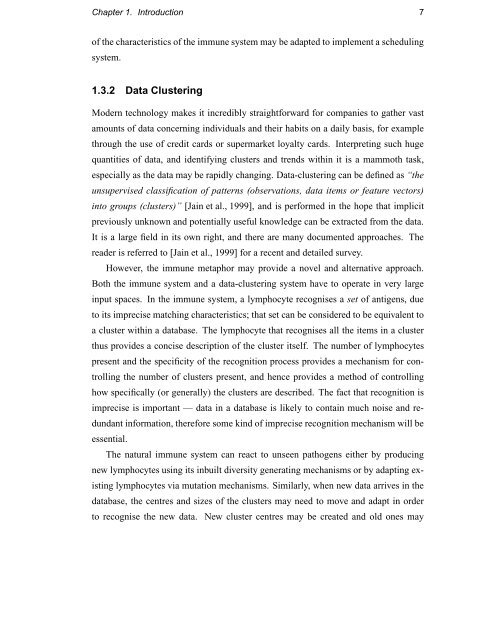Immunology as a Metaphor for Computational ... - Napier University
Immunology as a Metaphor for Computational ... - Napier University
Immunology as a Metaphor for Computational ... - Napier University
You also want an ePaper? Increase the reach of your titles
YUMPU automatically turns print PDFs into web optimized ePapers that Google loves.
Chapter 1. Introduction 7of the characteristics of the immune system may be adapted to implement a schedulingsystem.1.3.2 Data ClusteringModern technology makes it incredibly straight<strong>for</strong>ward <strong>for</strong> companies to gather v<strong>as</strong>tamounts of data concerning individuals and their habits on a daily b<strong>as</strong>is, <strong>for</strong> examplethrough the use of credit cards or supermarket loyalty cards. Interpreting such hugequantities of data, and identifying clusters and trends within it is a mammoth t<strong>as</strong>k,especially <strong>as</strong> the data may be rapidly changing. Data-clustering can be defined <strong>as</strong> “theunsupervised cl<strong>as</strong>sification of patterns (observations, data items or feature vectors)into groups (clusters)” [Jain et al., 1999], and is per<strong>for</strong>med in the hope that implicitpreviously unknown and potentially useful knowledge can be extracted from the data.It is a large field in its own right, and there are many documented approaches. Thereader is referred to [Jain et al., 1999] <strong>for</strong> a recent and detailed survey.However, the immune metaphor may provide a novel and alternative approach.Both the immune system and a data-clustering system have to operate in very largeinput spaces. In the immune system, a lymphocyte recognises a set of antigens, dueto its imprecise matching characteristics; that set can be considered to be equivalent toa cluster within a datab<strong>as</strong>e. The lymphocyte that recognises all the items in a clusterthus provides a concise description of the cluster itself. The number of lymphocytespresent and the specificity of the recognition process provides a mechanism <strong>for</strong> controllingthe number of clusters present, and hence provides a method of controllinghow specifically (or generally) the clusters are described. The fact that recognition isimprecise is important — data in a datab<strong>as</strong>e is likely to contain much noise and redundantin<strong>for</strong>mation, there<strong>for</strong>e some kind of imprecise recognition mechanism will beessential.The natural immune system can react to unseen pathogens either by producingnew lymphocytes using its inbuilt diversity generating mechanisms or by adapting existinglymphocytes via mutation mechanisms. Similarly, when new data arrives in thedatab<strong>as</strong>e, the centres and sizes of the clusters may need to move and adapt in orderto recognise the new data. New cluster centres may be created and old ones may









![Unit 5. Switches and VLANs [PDF]](https://img.yumpu.com/34422504/1/184x260/unit-5-switches-and-vlans-pdf.jpg?quality=85)






